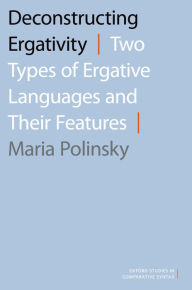Deconstructing Ergativity: Two Types of Ergative Languages and Their Features. Maria Polinsky

Deconstructing-Ergativity.pdf
ISBN: 9780190256593 | 408 pages | 11 Mb

- Deconstructing Ergativity: Two Types of Ergative Languages and Their Features
- Maria Polinsky
- Page: 408
- Format: pdf, ePub, fb2, mobi
- ISBN: 9780190256593
- Publisher: Oxford University Press, USA
Download free epub books google Deconstructing Ergativity: Two Types of Ergative Languages and Their Features RTF
Overview
Nominative-accusative and ergative are two common alignment types found across languages. In the former type, the subject of an intransitive verb and the subject of a transitive verb are expressed the same way, and differently from the object of a transitive. In ergative languages, the subject of an intransitive and the object of a transitive appear in the same form, the absolutive, and the transitive subject has a special, ergative, form. Ergative languages often follow very different patterns, thus evading a uniform description and analysis. A simple explanation for that has to do with the idea that ergative languages, much as their nominative-accusative counterparts, do not form a uniform class. In this book, Maria Polinsky argues that ergative languages instantiate two main types, the one where the ergative subject is a prepositional phrase (PP-ergatives) and the one with a noun-phrase ergative. Each type is internally consistent and is characterized by a set of well-defined properties. The book begins with an analysis of syntactic ergativity, which as Polinsky argues, is a manifestation of the PP-ergative type. Polinsky discusses diagnostic properties that define PPs in general and then goes to show that a subset of ergative expressions fit the profile of PPs. Several alternative analyses have been proposed to account for syntactic ergativity; the book presents and outlines these analyses and offers further considerations in support of the PP-ergativity approach. The book then discusses the second type, DP-ergative languages, and traces the diachronic connection between the two types. The book includes two chapters illustrating paradigm PP-ergative and DP-ergative languages: Tongan and Tsez. The data used in these descriptions come from Polinsky's original fieldwork hence presenting new empirical facts from both languages.
Download more ebooks:
Free ebooks to download pdf format Lush Life 9780312428228 (English Edition) CHM iBook ePub
Free downloadable books in pdf Great Boss Dead Boss: How to Exact the Very Best from Your Company and Not Get Crucified in the Process
Books audio free downloads Indra's Pearls: The Vision of Felix Klein (English literature) CHM
Free ebooks and pdf files download Nature Guide: Gems 9781465402189 (English literature) by DK Publishing
E book document download The Golden Tresses of the Dead: A Flavia de Luce Novel PDB by Alan Bradley in English
0コメント